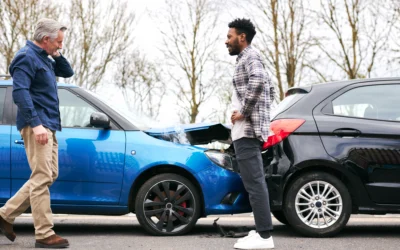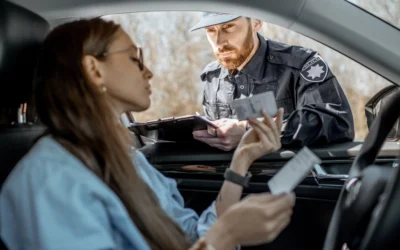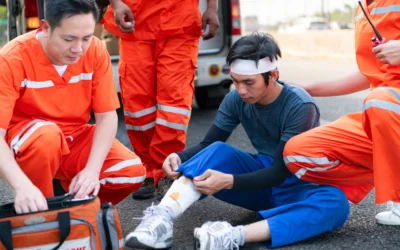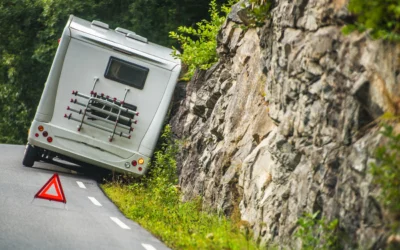Maximize Your Recovery by Ensuring Fair Compensation
When a car accident occurs, determining who is at fault can be complicated. This is where the comparative negligence law becomes essential. Knowing this law is vital for anyone involved in a car accident in Nevada. Fortunately, you can better understand comparative negligence law with Nevada car accidents attorney.
Knowing how comparative negligence works can help you protect your rights and potentially secure compensation, even if you are partially at fault. This law helps figure out how much blame each driver shares in an accident. To learn more about how comparative negligence law affects your situation, read on.
Quick Summary:
- Comparative negligence is a legal principle used in personal injury cases, like car accidents, to fairly determine fault among all parties. This impacts how much compensation a victim receives, even if they are partly at fault.
- Nevada uses a modified comparative negligence system. This means someone over 50% at fault cannot recover damages, unlike some states where any fault bars recovery.
- Nevada law (NRS 41.141) allows recovery if you’re 50% or less at fault. This “50% rule” ensures partial blame doesn’t eliminate compensation, and fault is assessed based on evidence and testimony.
- After an accident, gather evidence (photos, statements) to support your claim. You must file a claim within two years of the accident. A successful claim will ensure you get benefits, such as medical coverage, and more.
- Consulting a Nevada car accident attorney can help you understand your rights and manage the legal process smoothly. They offer different advantages in creating your claim. With their help, you can succeed in this legal process.
What is Nevada’s Modified Comparative Negligence Law?
Comparative negligence law helps determine fault in personal injury cases. It allows for a fair assessment of blame among parties involved in an accident. This approach can significantly impact the compensation a victim may receive.
Definition and Explanation of Modified Comparative Negligence
In Nevada, modified comparative negligence allows a victim to seek compensation as long as their degree of fault does not exceed that of the defendants. Under Nevada Revised Statute (NRS) 41.141, if a person is found to be more than 50% at fault, they cannot recover any damages.
This contrasts with some states that follow a contributory negligence model, where any fault on the victim’s part can completely bar recovery.
The 50% Rule in Nevada Car Accident Cases
The 50% rule is central to Nevada’s modified comparative negligence system. It stipulates that a plaintiff can only recover damages if their percentage of fault is 50% or less.
If they are found to be 51% or more at fault, they are barred from recovering any compensation. This threshold significantly impacts how car accident claims are processed and resolved.
Impact on Insurance Claims and Settlements
The modified comparative negligence system influences insurance claims and settlements by determining how much compensation a victim can receive based on their level of fault.
For instance, if a plaintiff is found to be 30% at fault for an accident with total damages of $10,000, they would recover $7,000 (i.e., $10,000 minus 30%). This allocation encourages fair settlements based on the degree of each party’s negligence.
Types of Negligence in Nevada Car Accidents
A driver’s negligence of the road and their fellow drivers is the main cause of car accidents. Driver negligence can take many forms in car accidents. These actions can contribute to an accident and affect the determination of fault. including:
- Distracted driving (e.g., texting while driving)
- Speeding or aggressive driving
- Driving under the influence of drugs or alcohol
- Failing to obey traffic signals or signs
Multiple Party Involvement Scenarios
In cases where multiple parties are involved, such as multi-car collisions, the comparative negligence system becomes even more important. Each driver’s level of responsibility will be assessed to determine how damages should be allocated among them.
For example, if three drivers are involved in an accident and one is found 40% at fault while the others share the remaining 60%, each party’s compensation will be adjusted according to their respective percentages of fault.
Role of Evidence in Determining Fault Percentages
Evidence plays an important role in establishing fault percentages in car accidents. It ultimately affects the compensation awarded to each party involved in the accident. Evidence may include:
- Police reports detailing the circumstances of the accident
- Eyewitness testimonies
- Traffic camera footage or photographs from the scene
- Professional analysis from accident reconstruction professionals.
How Does the Comparative Negligence Law Affect Car Accident Claims?
How does comparative negligence affect car accident claims in Nevada? Comparative negligence has a significant effect on personal injury claims in Nevada.
It determines how much compensation a victim can receive based on their level of fault. This is where understanding fault distribution in Nevada car accidents is your first step in creating a claim.
Fault Distribution and Recovery Rights
In Nevada car accident cases, courts determine fault percentages by analyzing the actions of all parties involved. The process involves evaluating evidence to assign a percentage of responsibility to each party. This directly impacts compensation eligibility under Nevada’s modified comparative negligence system.
Investigation Process and Evidence Gathering
The investigation process typically includes collecting evidence such as photographs, police reports, and physical damage assessments. This evidence is important in reconstructing the accident and determining who was at fault.
Role of Law Enforcement Reports
Police reports play a significant role in fault determination. These reports often include observations from officers at the scene. It can also include statements from involved parties, and citations issued for traffic violations.
Witness Statements and Their Importance
Witness statements can provide unbiased accounts of what occurred during the accident. Courts and insurance companies heavily rely on these testimonies to corroborate or challenge claims made by the involved parties.
The 51% Bar Rule in Practice
Under Nevada’s 51% bar rule, a plaintiff can recover damages if their fault is 50% or less. For example, If a driver is 40% at fault for an accident with $20,000 in damages, they can recover $12,000 (60% of the total). If they are found 51% at fault, they are barred from recovering any damages.
The 51% threshold limits recovery for plaintiffs with the most fault. This rule ensures that compensation is only available to those less negligent than the defendants.
Insurance Company Negotiations
Insurance companies often use fault percentages to negotiate settlements. They may argue for higher fault percentages for plaintiffs to reduce payouts. This makes clear documentation and evidence necessary during negotiations.
Documentation Requirements
In Nevada car accident cases, proper documentation is important for establishing fault and securing compensation. Having these documents organized and accessible can significantly strengthen a claim. Here are the types of documentation needed:
- Medical Records: Prove injuries, treatment costs, and long-term impacts.
- Accident Scene Photographs: Provide visual evidence of vehicle positions, road conditions, and damages.
- Vehicle Damage Reports: Document the extent of damage, estimate repair costs, and indicate impact severity.
What Should I Do After Experiencing a Car Accident in Nevada?
After a car accident, knowing what to do is extremely important. Taking the proper steps can help ensure your safety and protect your rights. Here are important actions you should immediately take following an accident in Nevada:
- Immediate Actions Following an Accident
First, stop your vehicle and remain at the scene. Leaving can lead to serious legal issues. Next, check for injuries among everyone involved. If anyone is hurt, call 911 for medical help right away.
- Importance of Documenting the Accident Scene
Documenting the scene is very important. Take photos of the vehicles, any damage, and the surrounding area. These images can serve as evidence later. Additionally, gather contact information from witnesses. Their statements may help clarify what happened.
- Obtaining Medical Care
Even if you feel fine, seek medical attention after the accident. Some injuries may not show symptoms right away. Getting checked by a doctor ensures you receive necessary care and creates a medical record that can support your claim.
- Influencing the Outcome of a Comparative Negligence Claim
The steps you take after an accident can affect your claim’s outcome. Proper documentation and timely medical care strengthen your case. Following these steps can better protect your rights and improve your chances of receiving fair compensation.
Time Limits and Statute of Limitations
The statute of limitations is a legal deadline ensuring claims are filed while evidence remains fresh. Witnesses’ memories can become unreliable as time goes on, leaving you without any legal recourse for recovering damages. Claims must be filed within two years from the date of the accident, as per Nevada law.
Types of Recoverable Damages
Individuals injured in car accidents have the right to seek compensation for various damages resulting from the incident. Injured parties may claim multiple damages, such as:
- Medical Expenses: Covers all medical costs related to the injury, including hospital bills, surgeries, and ongoing care.
- Lost Wages: Compensation for income lost due to inability to work, including current and future earnings.
- Pain and Suffering: Damages for physical pain and emotional distress, such as anxiety and loss of enjoyment of life.
- Property Damage: Compensation for repairing or replacing the damaged vehicle and personal belongings.
- Emotional Distress: Additional compensation for psychological trauma resulting from the accident.
- Loss of Consortium: Damages awarded to a spouse for loss of companionship and support due to the injured party’s condition.
- Punitive Damages: Awarded in cases of extreme negligence or intentional misconduct to punish the at-fault party.
How Can an Attorney Help Me With My Car Accident Claim?
A Nevada car accident attorney can play an important role for you after an accident. They help you understand your rights and the laws that apply to your case. Hiring an attorney can make a significant difference in the outcome of your claim.
Benefits of Hiring an Attorney
An attorney who knows Nevada’s comparative negligence laws can provide valuable guidance. They understand how these laws affect your case and can help you build a strong claim. With their knowledge, you can feel more confident about pursuing compensation for your injuries.
Assistance with Evidence Collection
Collecting evidence is key to a successful claim. An attorney can assist you in gathering necessary documents, photos, and witness statements. They know what evidence is needed to support your case and can ensure nothing is overlooked.
Managing Negotiations with Insurance Companies
Dealing with insurance companies can be challenging. An attorney can handle negotiations on your behalf, ensuring you do not settle for less than you deserve. They know how to argue for fair compensation based on the facts of your case.
Legal Representation in Court
If your case goes to court, having an attorney is very important. They will represent you and present your case effectively to the judge and jury. Their experience in court can help you achieve the best possible outcome for your claim.
Our Personal Injury Lawyers Can Assist You With Your Car Accident Claims Today!
Understanding the comparative negligence law is important for anyone involved in a car accident in Nevada. This law allows victims to seek compensation even if they share some fault. Knowing your rights can help you manage the legal process more effectively. It’s even better learning the comparative negligence law with help from a Nevada car accidents attorney.
At Joey Gilbert Law, our attorneys are ready to assist you with your car accident claims. Our team of attorneys have the skill and experience to handle issues raised from your car accident case. We can ensure you get the compensation you deserve.
We also offer services in personal injury and criminal law. If you have questions or need guidance, we encourage you to book a free consultation with us today. Your recovery and rights matter to us, and we are here to help you every step of the way.




